
“Success is no accident. It is hard work, perseverance, learning, studying, sacrifice, and most of all, love of what you are doing or learning to do.” – Pelé
The Kansas State Wildcats football program stands as a testament to the glorious highs and heartbreaking lows that characterize college athletics. With a rich history in NCAA Division I Football Championship Subdivision, Kansas State football has seen its share of struggles, including a 28-game losing streak from 1945 to 1948, and the distinction of being the first NCAA team to lose 500 games by 1988. Yet, amid these challenges, the spirit of purple pride and resilience has thrived in Manhattan, Kansas.
Under the legendary Bill Snyder, the K-State athletics program experienced a renaissance, transforming from the worst record in Division I-A to achieving six top-ten finishes in the AP Poll and a remarkable 11-0 regular season in 1998. The legacy of Wildcats football reflects a journey of determination where each game resonates with the spirit of community and passion, laying the groundwork for future successes while honoring the past.
Key Takeaways
- Kansas State football has an all-time record of 476–612–41.
- Bill Snyder’s leadership turned a dismal program into a competitive powerhouse.
- The Wildcats had only four winning seasons in a span of 55 years from 1935 to 1990.
- In 1993, Kansas State secured its first bowl game victory under Snyder.
- The spirit of K-State athletics fosters enduring community support and pride.
History of Kansas State Football
The saga of kansas state football history began with its establishment in the late 19th century. The Wildcats faced numerous challenges as they laid the groundwork for a program that would evolve over the next century. Early college football was rife with experimentation, and Kansas State was no exception. From its formative years, the team experienced a mixture of triumphs and tribulations, which would become integral to its identity.
Early Years and Formation
The Kansas State Wildcats football program began competing in 1896 during a time when football was still new to many American institutions. Early matches often involved a lack of organized strategy, leading to unpredictable outcomes. The initial match resulted in a loss that foreshadowed the struggles yet to come. Coaching changes became common, with figures such as Mike Ahearn and Guy Lowman stepping in to guide the struggling team through its formative years.
Key Milestones in the 19th Century
Throughout the 19th century, the Wildcats faced a series of challenges that would define their early trajectory. Key milestones included the impressive turnaround initiated by Bill Meek in the mid-1950s, as he led the team to its first winning season since 1936. Vince Gibson later made pivotal changes, achieving the program’s first victory over Nebraska in over a decade in 1968. Despite a tumultuous start, Kansas State football began to establish a foothold that laid the groundwork for future success.
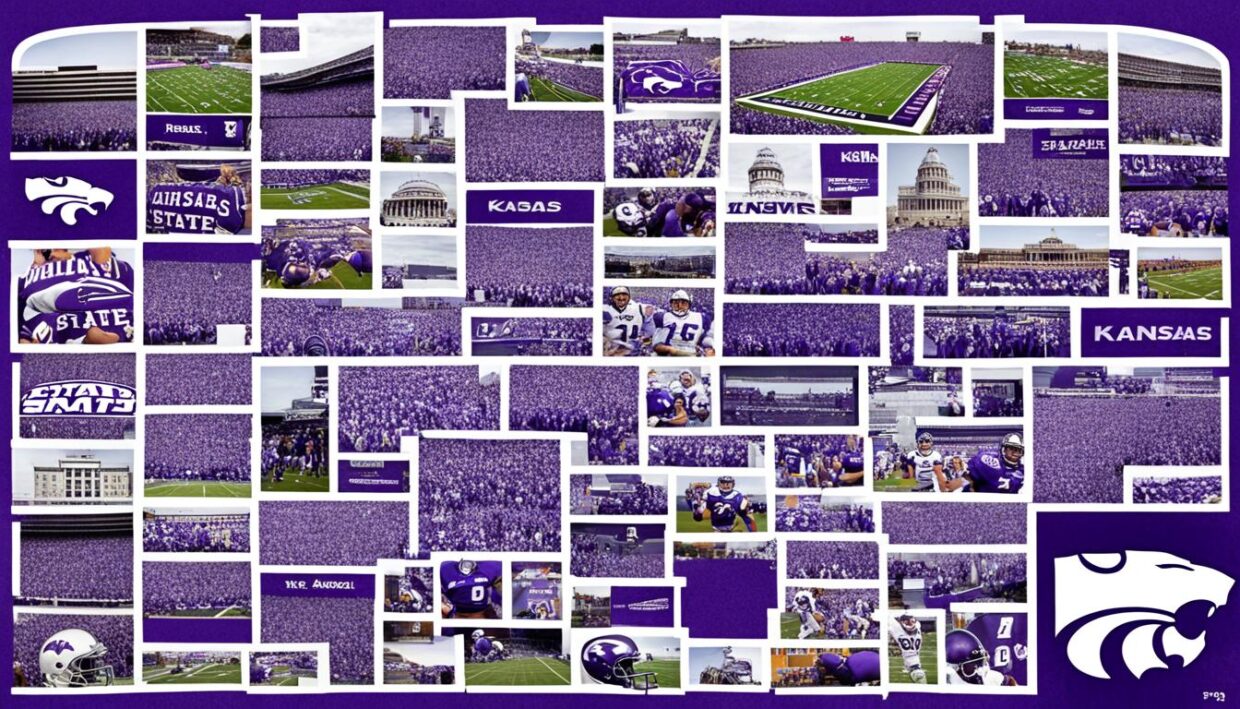
| Year | Milestone/Event |
|---|---|
| 1896 | First official season |
| 1953 | First winning season since 1936 |
| 1968 | First victory over Nebraska in 10 years |
| 1998 | Undefeated regular season under Bill Snyder |
| 2022 | Most recent conference title win |
Significant Eras of Development
The history of Kansas State football has seen remarkable transformations, particularly during the pivotal eras led by influential coaches. Each significant period reflects the progress and challenges faced by the Wildcats, shaping their identity in college football.
First Bill Snyder Era
Bill Snyder began his tenure as head coach in 1989, marking the start of a groundbreaking change for the Wildcats. Under his guidance, Kansas State transitioned from a struggling program to a competitive force. The Wildcats achieved consistent bowl appearances and solid standings in national rankings. Snyder’s leadership laid the foundation for what would later be recognized as the Bill Snyder legacy. This era was characterized by a notable turnaround, with K-State culminating in its first bowl victory in the 1993 Copper Bowl, defeating Wyoming with an impressive score of 52-17. The 1998 season was particularly significant, as the Wildcats reached a historic No. 1 ranking in the ESPN/USA Today coaches poll.
Revival Under Ron Prince
After Snyder’s initial departure, Ron Prince took the reins of the program. This period saw a brief resurgence in K-State football revival, as the team experienced a semblance of success in a competitive Big 12 landscape. Though this epoch did not match the peaks established during Snyder’s first era, it kept the team competitive and positioned them for future growth. However, challenges ultimately prompted a need for a return to earlier foundational principles.
Bill Snyder’s Return
In 2009, the return of Bill Snyder to Kansas State signified a renewed commitment to excellence in football. His second tenure not only reinforced his legacy but revitalized the program. Under his guidance, the team regained stability and competitiveness, re-establishing itself as a player in the Big 12. Each victory under Snyder served to underscore the importance of mentorship and strategic development, laying the groundwork for the Wildcats’ future aspirations while navigating the evolving landscape of kansas state football eras.
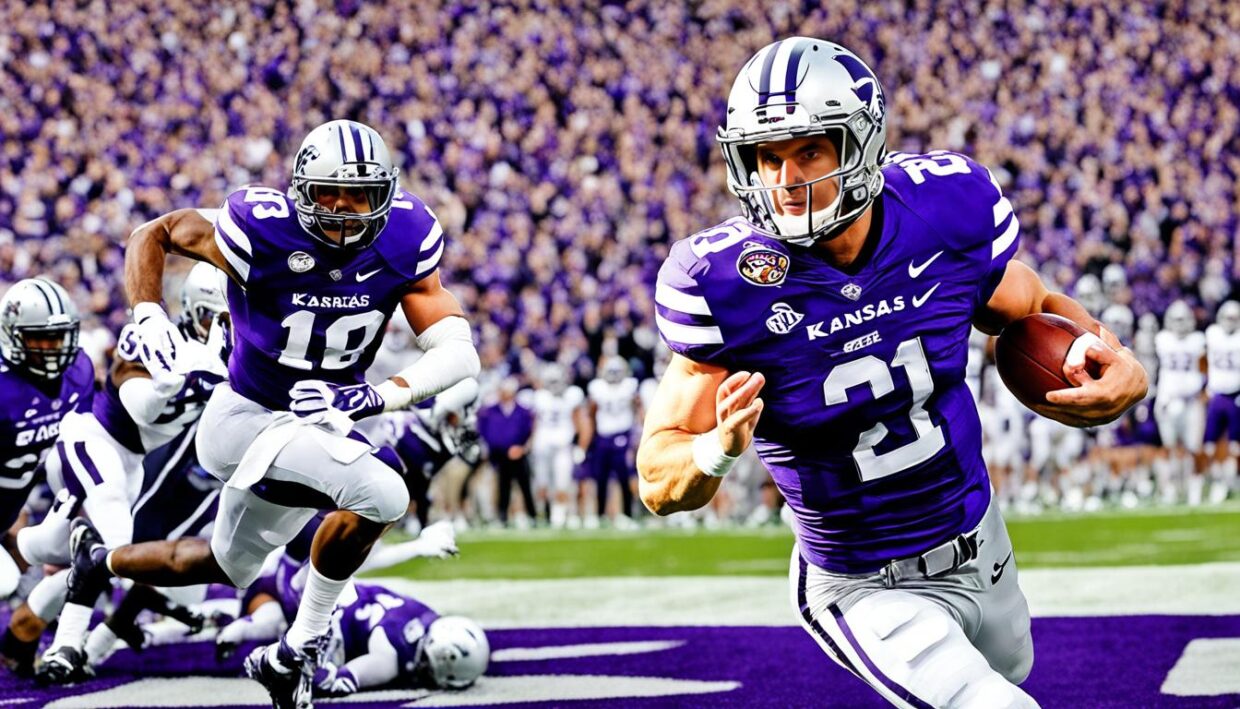
The Bill Snyder Legacy
Bill Snyder’s influence on Kansas State football transformed not only the program but also the entire athletics department. His leadership and vision brought about remarkable changes that established Kansas State as a powerhouse in college football. His methods and dedication led to an era marked by success and opportunity for athletes and the community alike.
Impact on Program Success
The Bill Snyder impact is undeniable, as his coaching tenure turned Kansas State football into a national contender. Under his guidance, the program enjoyed multiple top-10 finishes and established a tradition of excellence. Snyder’s focus on building a disciplined, hard-working team culture led to significant improvements in player performance and morale. Enrollment at Kansas State skyrocketed due to the heightened visibility and success of the football program, achieving an increase from 25,000 in 1989 to nearly 45,000 by 2000. This evolution laid the foundation for a vibrant campus environment, fostering a sense of pride among students and alumni. Furthermore, local businesses thrived through the economic stimulation brought about by football events, contributing to community growth.
Transformation of K-State Athletics
Snyder’s approach not only emphasized athletic prowess but also focuses on developing leaders both on and off the field. The Snyder Leadership Legacy Fellows program stands as a testament to his dedication towards shaping future leaders. This initiative encourages final-year students to engage with the community while fostering essential leadership skills. Activities range from monthly meetings to engaging discussions with Snyder himself. The system he developed, known as the 16 Goals for Success, serves as a compass for students pursuing excellence beyond athletics. With Snyder’s vision, K-State athletics underwent a significant transformation, becoming a model of discipline and achievement.

| Year | Enrollment | Top 25 Football Appearances | Community Improvement |
|---|---|---|---|
| 1989 | 25,000 | — | — |
| 2000 | 45,000 | Multiple | Local businesses grew, enhanced civic pride |
Home Stadium: Bill Snyder Family Football Stadium
The Bill Snyder Family Football Stadium stands as a monument to Kansas State University football, symbolizing the team’s rich heritage and vibrant game day atmosphere. Over the years, it has undergone extensive renovations that have transformed its original structure into a modern sports facility. With a seating capacity of 50,000, this stadium has witnessed thrilling moments in Wildcat Stadium history and has become a cornerstone of Kansas State football game day traditions.
Stadium History and Evolution
Originally opened in 1968 as KSU Stadium with a seating capacity of 35,000, the venue has experienced remarkable growth. Significant renovations took place in 1993, 2007, and from 2012 to 2017, culminating in a major upgrade from 2020 to 2021. During this time, the seating capacity was expanded and modern amenities were added, enhancing the experience for fans. Noteworthy additions include the $90 million West Side Stadium Center, unveiled for the 2013 season, and the Shamrock Zone, a luxurious club space introduced in September 2021.
Game Day Experience at Wildcat Stadium
Game day at Bill Snyder Family Football Stadium is a vibrant celebration of Wildcat spirit, where thousands gather to cheer on the Kansas State Wildcats. The atmosphere is electric, with fans dressed in school colors and eager to support their team. As of the 2022 season, two locations within the stadium offer alcoholic beverages to enhance the fan experience. The unveiling of new facilities, like the Vanier Football Complex in 2015, adds to the accessible amenities aimed at making every game memorable. With a record attendance of 53,811, the excitement of Kansas State football game day continues to thrive.
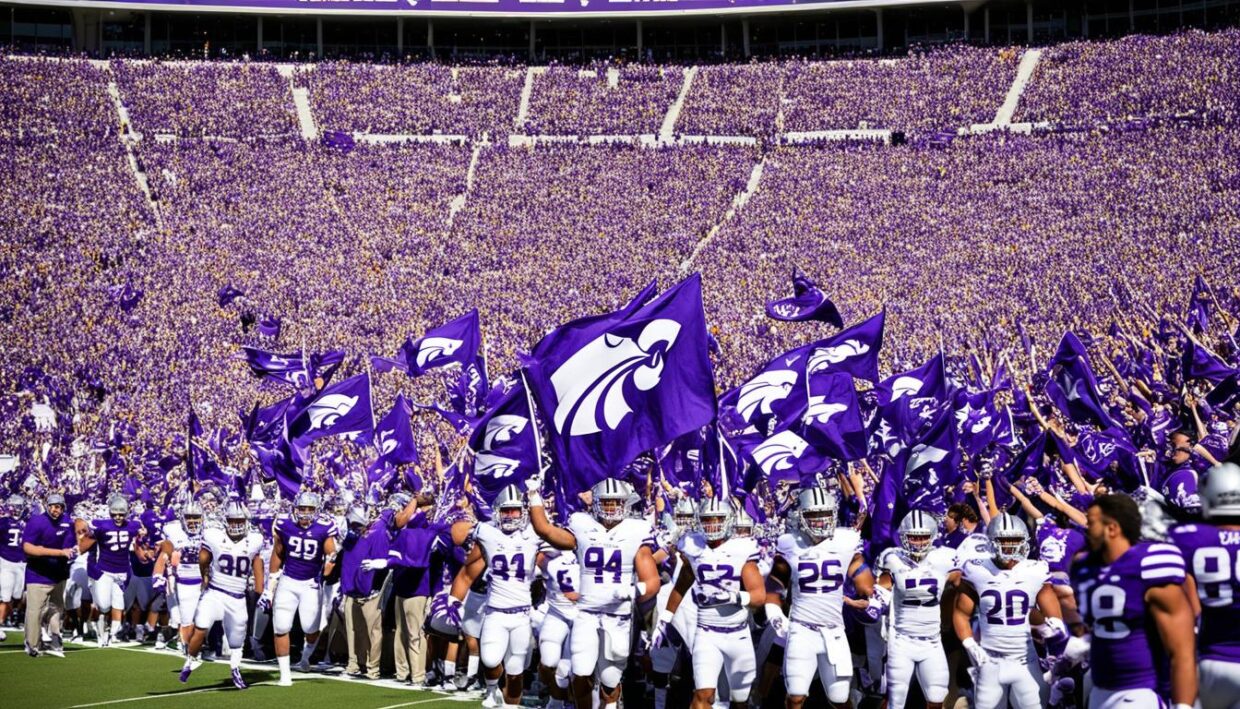
Current State of Kansas State Football
The current kansas state football status reflects a team that is ready to make a significant impact in the Big 12 Conference. As the 2024 kickoff approaches, excitement builds with daily player profiles highlighting the talent within the squad. Each profile provides comprehensive insights into positions such as defensive end, linebacker, long snapper, running back, and offensive lineman, emphasizing the depth in the roster.
K-State Wildcats aim to blend experienced seniors and juniors with fresh talent, including freshmen and redshirt freshmen. This recruitment strategy showcases the coaching staff’s foresight in preparing the team for both immediate success and future potential. Profiles reveal players’ key roles and physical attributes, with heights spanning from 5′ 9″ to 6′ 8″ and weights ranging from 164 lbs to 348 lbs.
The variety in player experience adds to the k-state Wildcats’ competitive edge. Although the 2020 season didn’t impact eligibility, many players continue to advance classifications, generating a robust mix of experienced and younger players. This foundation enables Kansas State Football to build upon their current big 12 performance, preparing them to be contenders for conference titles as the season unfolds.
| Position | Height | Weight | Class |
|---|---|---|---|
| Quarterback (QB) | 6′ 3″ | 210 lbs | Sr |
| Defensive End (DE) | 6′ 4″ | 250 lbs | Jr |
| Running Back (RB) | 5′ 11″ | 205 lbs | Fr |
| Wide Receiver (WR) | 6′ 1″ | 190 lbs | So |
| Offensive Lineman (OL) | 6′ 6″ | 320 lbs | Sr |
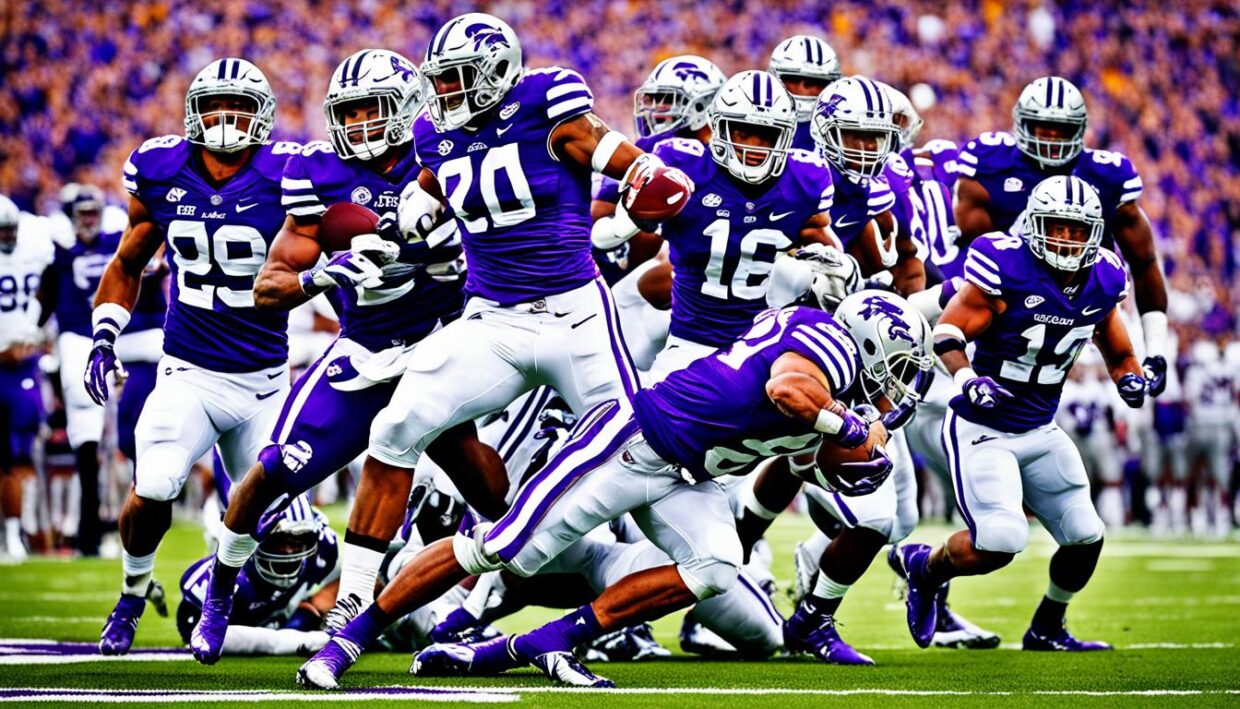
Rivalries in Kansas State Football
The landscape of Kansas State football is undeniably shaped by its intense rivalries, with a focus on competition that goes beyond wins and losses. Chief among these contests is the Sunflower Showdown, pitting Kansas State against the University of Kansas, a contest steeped in tradition. Furthermore, rivalries with Iowa State and Nebraska contribute richly to the fervor surrounding kansas state rivalries, fostering a sense of local pride and regional recognition.
Sunflower Showdown: Kansas vs. Kansas State
As they prepare for their 110th consecutive meeting, the rivalry with Kansas is one of the oldest and most notable in college football. The two teams have faced off 118 times since 1924, with the record tied at 47-47-2. In recent decades, Kansas State has asserted dominance, claiming a 24-6 record against Kansas since 1990. This success reflects not only in the number of wins but in the scoring margin, where the Wildcats have consistently outpaced the Jayhawks by nearly three touchdowns per game.
The Battle with Iowa State
The competition with Iowa State further enriches the Kansas State football narrative. This rivalry showcases competitive matches that bring out the best in both teams, engaging fans and drawing attention across college football. Each encounter heightens the drama, as both squads vie for bragging rights within the Big 12 Conference framework.
Historic Rivalry with Nebraska
The historical rivalry with Nebraska stands as a testament to Kansas State’s competitive spirit. While not played annually, the significance of past matchups continues to resonate, leaving an indelible mark on both programs. Fans reminisce about the fierce encounters that shaped seasons and heralded achievements. Events from this storied relationship underscore its importance among historical rivalries.
| Rival Team | Series Record | Recent Performance | Key Rivalry Highlights |
|---|---|---|---|
| Kansas | 47-47-2 | 24-6 (since 1990) | Longest winning streak: 11 games |
| Iowa State | Competitive Record | N/A | Intense local rivalry |
| Nebraska | Historic Rivalry | N/A | Memorable matches |

Traditions and Pageants
Kansas State is known for its vibrant kansas state traditions that engage students and fans alike, particularly on game days. Central to this lively atmosphere is the beloved wildcat mascot, Willie the Wildcat, who plays an essential role in K-State’s identity. Fans proudly don the school’s signature purple and white colors, a unifying detail that speaks to the school spirit seen throughout the campus.
School Colors and Mascot
The colors purple and white are more than just hues; they symbolize the dedication and pride of the Kansas State community. These shades are prominently displayed on game days, creating a sea of purple in the stands. The wildcat mascot embodies the fierce spirit of the Wildcats, energizing the crowd and bringing a sense of camaraderie among fans. His presence enhances the overall excitement of the games, making him a cherished figure at K-State events.
Unique Game Day Traditions
Game day experiences at Kansas State are filled with unique traditions that elevate the atmosphere. From tailgating in the parking lots to the exhilarating pre-game ceremonies, fans eagerly anticipate each season. Notable events like the parade during the Miss Kansas pageant contribute to the local culture, showcasing the close-knit relationship between the university and the Pratt community. This pageant, held since 1955, has provided over $58,000 in scholarships this year alone, highlighting the community’s investment in its future.
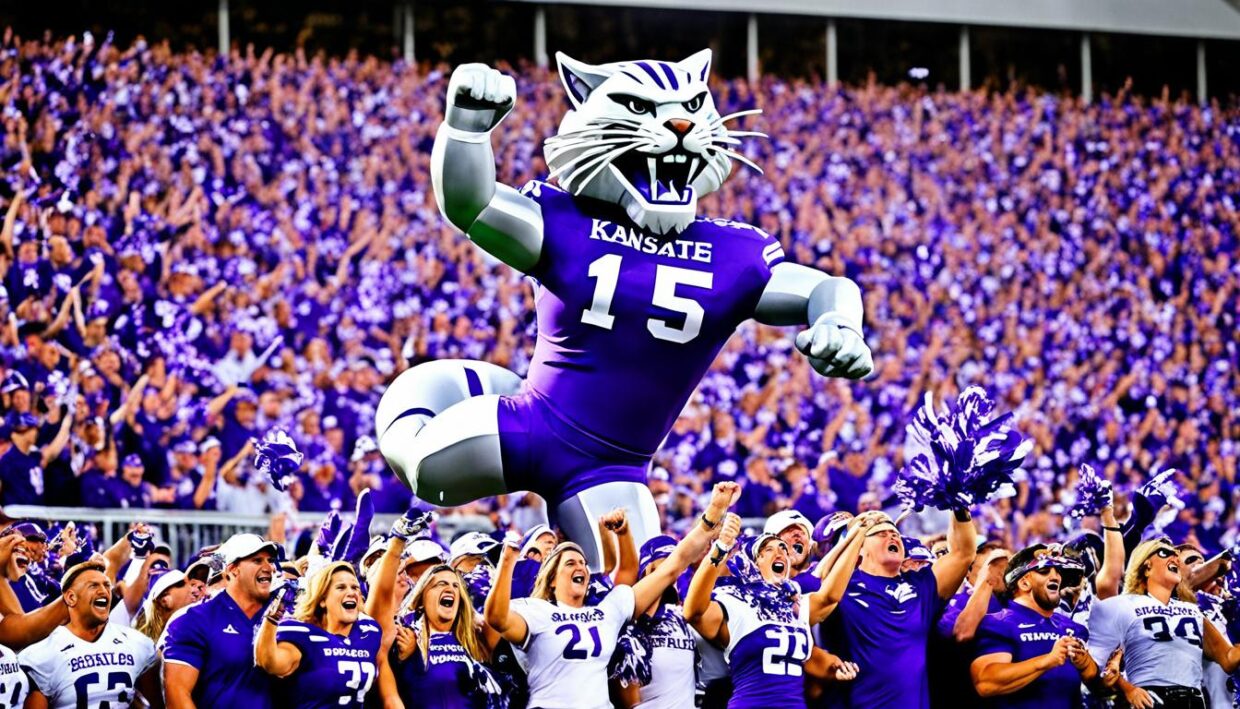
Each game day ritual fosters a sense of belonging, where alumni and students alike come together to celebrate their team. Traditions such as the National Anthem sung with passion and the spirited chants from the stands create an invigorating backdrop that ensures every game feels special. These game day experiences not only strengthen community bonds but also foster a legacy of team pride that continues to grow with each passing season.
Notable Players in Kansas State Football History
Kansas State football has been graced by numerous talented players who have gone on to achieve great heights, leaving a lasting impact on the program. The alumni achievements of these kansas state football players not only showcase their hard work during their college years but also their contributions to professional football, particularly as NFL Wildcats. Many of these players have set records and received accolades that highlight their skills and dedication.
Achievements and Awards
Throughout its history, Kansas State has produced players who have claimed prestigious awards and broken records. The efforts of a standout kicker, for instance, saw him finish his career with an impressive 83.3% field goal percentage, ranking highly in both school and Big 12 history. He not only finished third in career field goals made but also had significant single-season accomplishments, including a perfect 2020 season. Other notable achievements include accolades earned during key games and moments that have left an indelible mark on the Wildcats’ legacy.
Former Players in the NFL
Many kansas state football players have transitioned seamlessly into successful NFL careers, becoming key contributors for their teams. The program boasts an alumni network that includes stars recognized for their excellence on the field. Recruitment data reveals that players in positions like Defensive End and Edge Rusher not only faced intense competition but also showcased their skills across various colleges before joining the Wildcats. This diverse recruitment process reflects the desired versatility and talent found among alumni, further solidifying the reputation of Kansas State as a premier program for developing professional football talent.

Bowl Game History
Kansas State football boasts a rich tradition in postseason play, with the program establishing itself as a competitive force in college football through numerous k-state bowl appearances. Since its inception, the Wildcats have participated in a total of 25 bowl games, showcasing their ability to thrive on the grand stage. The program’s kansas state bowl history is punctuated by significant bowl games that not only highlight the skills of the players but also enhance the school’s reputation nationally.
Memorable Bowl Appearances
The Wildcats first participated in a bowl game in 1982 when they faced Wisconsin in the Independence Bowl. This marked the beginning of an exciting journey through significant matchups. Under the leadership of coach Bill Snyder, K-State made its mark in various prestigious bowls, securing victories in the Holiday Bowl, Cotton Bowl, and Fiesta Bowl. Over the years, the team has celebrated noteworthy performances in six “New Year’s Six” bowl games, which include the Fiesta and Cotton Bowls.
Attendance for these bowl games has varied dramatically, from 31,111 fans at the Pop-Tarts Bowl to a stunning 80,956 spectators during the Cotton Bowl, reflecting the passion and loyalty of K-State supporters. One of the highlights of the program came during the 2012 Cotton Bowl Classic, where the Wildcats clashed with the Arkansas Razorbacks in a thrilling contest that drew a record crowd to Cowboys Stadium.
K-State remains a formidable presence in the world of bowl games, being one of only 16 Power 5 schools to advance to a bowl game in 12 of the last 14 years. Since 1993, the Wildcats have competed in 11 different bowls across nine states, showcasing the widespread appeal of their football program. On average, nearly 30,000 fans have attended their games throughout the Continental U.S., indicating strong support from the K-State community.
Notably, the 1997 Fiesta Bowl victory over Syracuse remains etched in the memories of fans, drawing just under 40,000 K-State supporters to Tempe, Arizona. As the Wildcats continue to build their legacy, memorable moments from their bowl history will remain an integral part of the K-State narrative.
| Year | Bowl Game | Opponent | Attendance |
|---|---|---|---|
| 1982 | Independence Bowl | Wisconsin | N/A |
| 1997 | Fiesta Bowl | Syracuse | Estimated 40,000 |
| 2012 | Cotton Bowl Classic | Arkansas | 80,956 |
| 2022 | Caesars Superdome | Alabama | 60,437 |
| 2023 | Camping World Stadium | NC State | 31,111 |
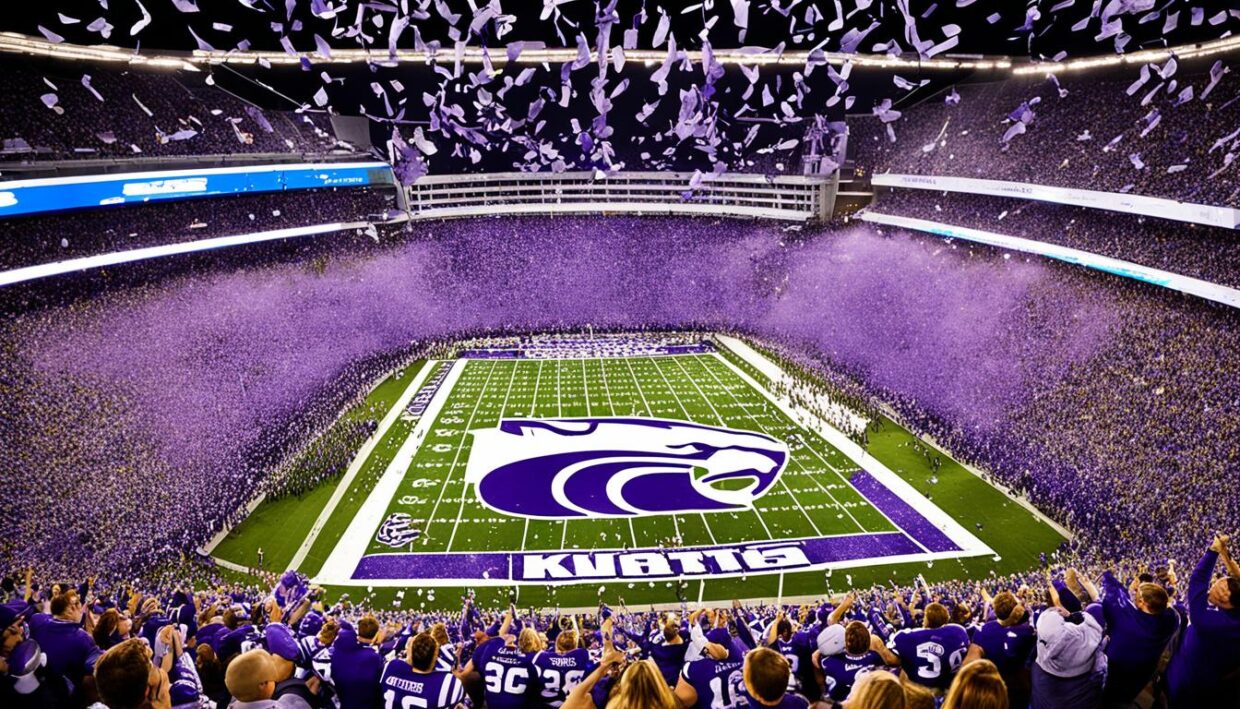
Kansas State Football in the Big 12 Conference
The Kansas State football program has experienced a significant transition as it adjusted to the dynamics of the big 12 conference. This shift not only demanded greater competitiveness but also provided increased visibility for the Wildcats. Over the years, K-State has made notable achievements within the conference, exhibiting resilience amidst demanding matchups.
Transition to the Big 12
Kansas State’s entrance into the big 12 conference opened doors to a higher level of competition. As they navigated this new landscape, the football program encountered numerous veteran teams, challenging the Wildcats to up their game. The overall record against teams in this conference showcases Kansas State’s enduring spirit. A total of 141 wins and 100 losses in matchups against big 12 rivals establishes a win percentage of 58.5%. This performance reflects the dedication to continually improve and succeed.
Recent Performance in the Conference
In recent seasons, Kansas State football has demonstrated strong performance metrics, contributing to positive momentum in the big 12 conference. Current records indicate a fresh start with a 0-0 standing, an outcome shared with several teams across the conference. Despite this initial result, past performances paint a more vivid picture, showcasing K-State’s competitive edge with win percentages of 66.7% in 2023 and an impressive 80.0% in 2022. Individual game results reveal a blend of narrow victories and challenges that have forged the Wildcats’ resolve.
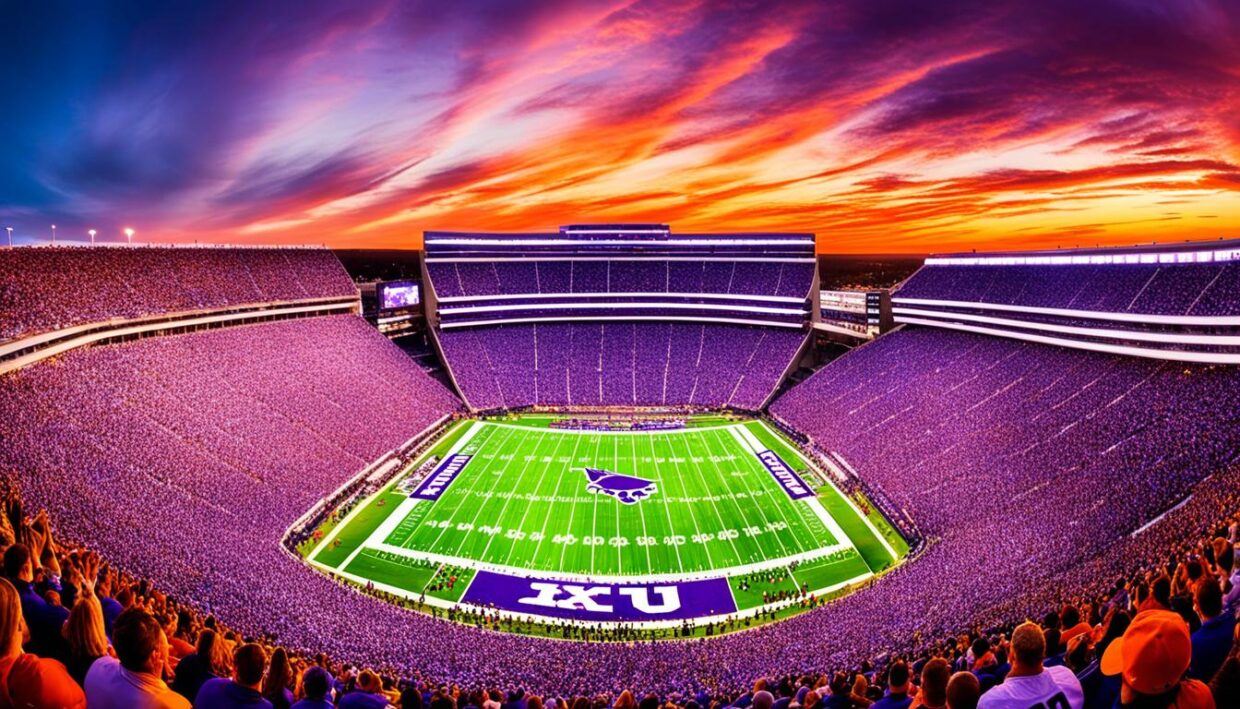
| Year | Win Percentage | Overall Record |
|---|---|---|
| 2023 | 66.7% | 0-0 |
| 2022 | 80.0% | 0-0 |
| 2021 | 44.4% | 0-0 |
| 2020 | 44.4% | 0-0 |
As K-State continues to evolve in the big 12 conference, its commitment to excellence remains steadfast. Each season brings new opportunities to further solidify the program’s legacy, reflecting a bright future for Kansas State football.
Statistics and Records
Kansas State football records showcase an impressive history of winning statistics and remarkable player achievements. The Wildcats began their journey in intercollegiate football in 1896, although they consider the modern era to have started in 1949 due to incomplete records prior to that date. Over the years, the program has evolved, contributing to the establishment of robust winning statistics.
All-time Winning Records
The Wildcats have participated in numerous seasons, which have increased from 10 games to 12 since 1949. The integration of bowl games into single-season and career statistics since 2002 significantly enhanced the depth of winning statistics. The Wildcats have made 12 bowl game appearances during this time, further solidifying their position within collegiate football.
Individual Player Records
Individual player achievements reflect the program’s legacy. Key stats include:
- Passing Yards: Josh Freeman leads with 8,078 yards, while Skylar Thompson and Will Howard follow with 7,134 and 5,786 yards, respectively.
- Rushing Yards: Darren Sproles holds the top position with 4,979 yards, followed by Deuce Vaughn and John Hubert.
- Receiving Yards: Tyler Lockett leads with 3,710 yards, with Kevin Lockett and Jordy Nelson trailing behind.
- Touchdowns: Will Howard is the career leader in passing touchdowns with 48, while Collin Klein leads rushing touchdowns with 55 and Tyler Lockett tops receiving touchdowns with 29.
These Kansas State football records illustrate not only individual greatness but also the team’s overall success. Collectively, these stats continue to inspire future Wildcats, pushing them toward achieving even greater heights.
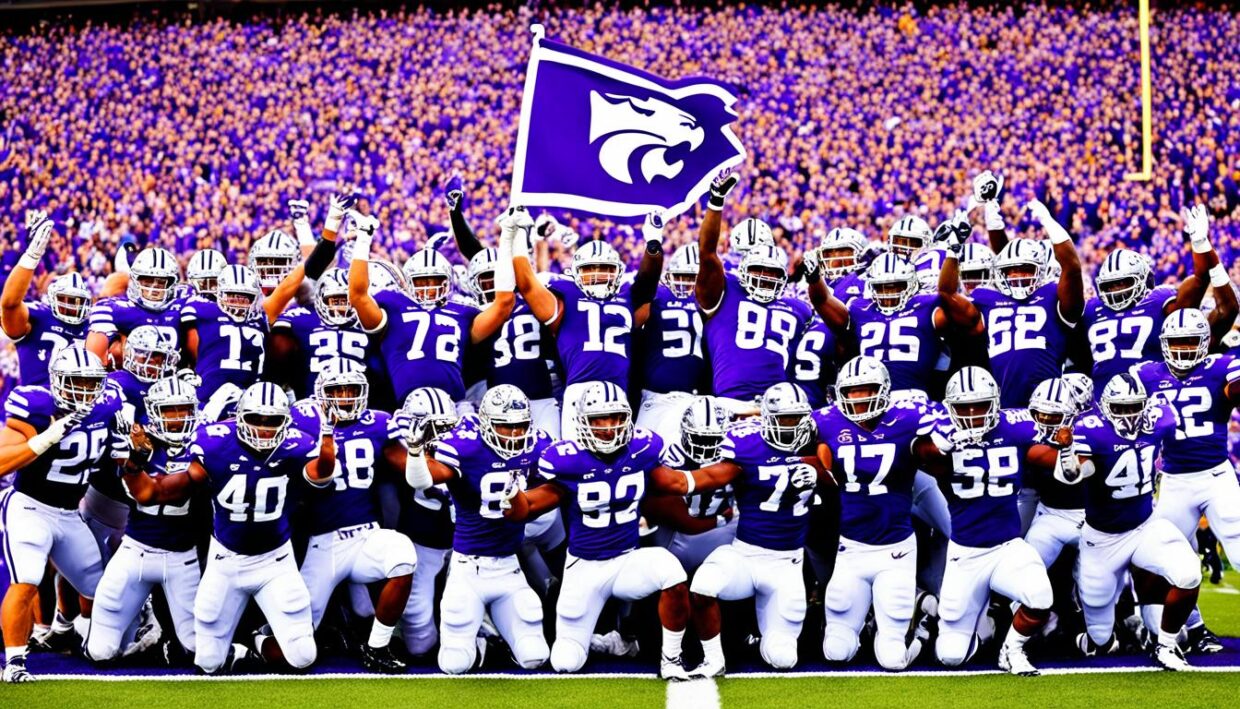
Future Prospects for Kansas State Football
The landscape of college football is rapidly evolving, making the future prospects for Kansas State football an intriguing topic. The Wildcats are strategically positioning themselves through innovative kansas state recruiting trends and effective k-state football strategies. As the dynamics shift, the focus is on leveraging talent acquisition to ensure the program remains competitive in the Big 12 and aims for national prominence.
Recruiting Trends and Strategies
The emergence of the transfer portal has transformed recruiting practices. Players frequently switch teams, complicating retention efforts for elite programs. This development allows Kansas State to access high-quality prospects, significantly improving their program future. At the same time, there is a risk of losing promising developmental players to more prominent teams.
Coaches are adapting by prioritizing regional recruits, as this approach is thought to increase player commitment. Although this assumption lacks solid statistical backing, the strategy aims to build a foundation of local talent that is likely to stay with the program. Furthermore, coaching staff members are exploring player development strategies that question the effectiveness of red-shirting and prioritize actual game exposure over bench time.
With standout performances from players like Avery Johnson and new commitments from top recruits, Kansas State’s recruitment is on an upswing. Johnson’s exceptional play highlights the potential for the Wildcats to rise as contenders. The offensive line looks to embrace a shift towards both athleticism and skill, with recruits such as Kaedin Massey and Gus Hawkins set to enhance the existing talent pool.

The upcoming seasons promise to be pivotal for Kansas State as they navigate these challenges and opportunities. The strategic emphasis on player development and targeted recruiting, coupled with significant contributions from new talents, paints an optimistic picture for the program’s future.
Conclusion
The kansas state football legacy is deeply rooted in a vibrant history, characterized by remarkable achievements, legendary figures, and intense rivalries that have captivated fans for decades. With each season, the Wildcats have not only showcased their skills on the field but also demonstrated a dedication to excellence that sets them apart in collegiate athletics. The commitment to fostering talent and promoting athletic success continues to be a driving force behind k-state athletics growth.
As the program evolves, the future of Wildcats football looks promising. With recent recruitment efforts aimed at improving roster depth in the offensive line and other critical positions, the coaching staff is working diligently to build a more competitive team. Addressing gaps in player development, particularly following the unique challenges presented by COVID-19, is vital. The depth of both experienced talent and new recruits will be essential in shaping the wildcats football future.
Looking ahead, Kansas State football remains poised to maintain its strong presence in college football. By focusing on rejuvenating their roster and enhancing program dynamics, the Wildcats aim to continue their ascension within the sporting landscape, ensuring that their legacy endures while inspiring new generations of players and fans alike.





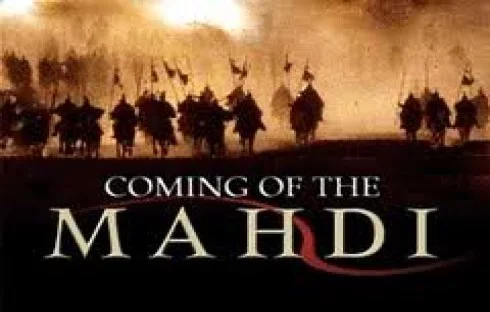













Be the first to leave a comment